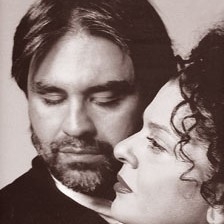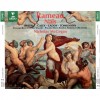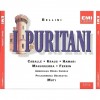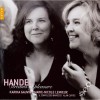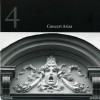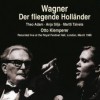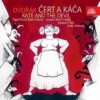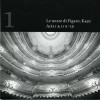Libretto
Tosca (Italian pronunciation: [ˈtoska]) is an opera in three acts by Giacomo Puccini to an Italian libretto by Luigi Illica and Giuseppe Giacosa, based on Victorien Sardou's drama, La Tosca. The work premiered at the Teatro Costanzi in Rome on January 14 1900. It is one of the world's most popular operas, a hit with audiences from its first performance.However it was not well received at first by the critics and was later dismissed by musicologist Joseph Kerman as a "shabby little shocker".Today, Tosca is a staple of the standard operatic repertoire and appears as number eight on Opera America's 2008 list of the 20 most-performed operas in North America.
Synopsis
Place: Rome. Time: June 1800.
Act 1
The church of Sant'Andrea della Valle "Recondita armonia"
Angelotti, an escaped political offender, seeks refuge in the church of Sant'Andrea della Valle where his family has a chapel. His sister, the Marchesa Attavanti, while praying for his release, has unwittingly served as a model to the painter, Mario Cavaradossi, for his portrait of the Magdalen. A few minutes before the church sacristan enters (followed shortly by Cavaradossi), the dissident conceals himself in his family's chapel. The sacristan assists the painter, washing his brushes. When Cavaradossi stops his work for a moment, he removes a medallion from his pocket: the medallion contains a miniature portrait of Tosca, his lover. The painter makes a comparison between Tosca and the model he has been portraying (Recondita armonia – "Concealed harmony").
The sacristan makes a controcanto (Scherza con i fanti e lascia stare i santi - which became a proverb: Joke with fools, but leave the saints in heaven), then leaves Cavaradossi alone to paint. When the sacristan leaves, Angelotti comes out of his chapel. Cavaradossi is his friend and political ally. Angelotti begins to tell of his escape from Castel Sant'Angelo (papal Roman prison), but the arrival of Tosca interrupts their conversation (Tosca: Mario! Mario! Mario!). Cavaradossi gives Angelotti some food and helps him return to hide in the chapel.
Floria Tosca is a singer, and she goes to the church to invite Cavaradossi to meet her after her performance that evening. Tosca is unreasonably jealous, however, and her suspicions have been aroused, having heard Cavaradossi's speaking to someone upon her arrival. She imagines an intrigue with a woman, and her fears are apparently confirmed by the developing portrait of Mary Magdalene. She tells Mario that the blue-eyed model looks very familiar. Finally, Tosca realizes Mario has used Marchesa Attavanti as the model, but he assuages her suspicions. Tosca has brown eyes, whereas the woman in the portrait has blue. (Qual occhio al mondo – "What eyes in the world can be compared to your eyes").
Tosca, her jealousy abated, leaves, but not before playfully insisting he make the Magdalene's eyes dark, like hers.
Angelotti reappears, and his escape is planned: Angelotti will don woman's attire—that his sister had hidden in the altar—and flee to Cavaradossi's villa; if necessary, Angelotti will hide in the painter's well. Cavaradossi swears, even if it costs him his life, he will save Angelotti from the authorities (La vita mi costasse, vi salverò – "Even if it costs me my life, I'll save you"). A cannon shot from the fortress (Castel Sant'Angelo) warns that the dissident's escape has been discovered and compels him to flee; the painter exits the church with him.
The sacristan returns surrounded by a laughing crowd of choir boys and acolytes. (Sacristan, chorus: Tutta qui la cantoria! – “All here, into the choir loft”) They falsely believe that Napoleon has been defeated and are there to sing a thankful Te Deum, when Scarpia, chief of police, arrives with his deputy Spoletta and some of his men in search of the escaped prisoner. In the Attavantis' chapel, Spoletta finds the fan of the Marchesa and the painter's basket emptied of food and wine. Scarpia threateningly asks the sacristan about this, but the latter maintains that Cavaradossi did not have the key to the chapel and had not expressed any interest in the food. Scarpia shrewdly surmises that Cavaradossi is somehow connected with Angelotti's escape.
Tosca returns to explain to Cavaradossi that she must perform in the celebration of cantata and will not be able to meet him later after all. Finding that Cavaradossi has left, she again begins to feel suspicious. Meanwhile the church fills up and a Cardinal prepares for the Te Deum.
Scarpia arouses Tosca's jealousy by producing Attavanti's fan, and she departs in anger. Ordering his agent to follow her (Tre sbirri, una carrozza – "Three policeman, a carriage"), he passionately avows his desire for the singer, then kneels devoutly in prayer. (Scarpia: Va' Tosca, nel tuo cuor s'annida Scarpia – "Go, Tosca, in your heart is nesting Scarpia"; Chorus: Adiutorium nostrum – "My help is in God's name"; Scarpia: A doppia mira tendo il voler – "At two goals I aim my desire").
Act 2
Scarpia's room at Palazzo Farnese (now the embassy of France)
Scarpia is dining alone while celebrations are heard outside. He sends a servant to give a note to Tosca to invite her to join him when she finishes with her recital. Cynically he sings of pleasure (Ella verrà per amor del suo Mario – "She will come out of love for her Mario" and Ha più forte sapore la conquista violenta – "The violent conquest has a stronger flavor") presuming she will surrender to his power.
Spoletta enters with Cavaradossi in custody but without Angelotti, who has eluded him. Scarpia closely questions the painter, but Cavaradossi reveals nothing. Tosca arrives and the painter whispers to her not to say anything about Angelotti. Scarpia sends Cavaradossi off to be tortured, then turns his attention to Tosca (Scarpia: Ed or fra noi parliam da buoni amici – “Now, let us talk like good friends”) Scarpia describes to her in detail her lover’s anguish under torture. She can hear his groans but is powerless to help him. At last, utterly prostrated, she divulges Angelotti’s hiding place. The painter is brought out, and Scarpia indicates he knows where Angelotti is hiding. In his pain and humiliation, Cavaradossi denounces Tosca for her betrayal of the secret. "Vissi d'arte"
Sciarrone enters to announce that earlier reports were mistaken: Bonaparte has defeated the royalist forces at the Battle of Marengo. Cavaradossi, exulting (Vittoria! - "Victory!"), is taken away to prison. Tosca attempts to follow him but is held back by Scarpia. She asks what the price will be to secure Mario's release (Scarpia: Mi dicon venal – “They say I'm venal.”) Scarpia avows his passion for the singer and lasciviously demands her body, her virtue, and herself, as the price. Tosca attempts to flee but is restrained by Scarpia as he attempts to rape her. During the struggle, drums are heard – Scarpia indicates that they are the drums beating Cavaradossi to the scaffold. Tosca finally collapses and asks the Lord the reason for all this cruelty against her (Tosca: Vissi d'arte, vissi d'amore – “I lived on art, I lived on love”; Scarpia: Sei troppo bella, Tosca, e troppo amante – “You're too beautiful, Tosca, and too loving”). Spoletta enters to announce that Angelotti has committed suicide just as Scarpia’s agents discovered him—in the well at Cavaradossi’s villa.
Feeling as if she has no alternative, Tosca finally agrees to yield. Scarpia orders Spoletta to organize for a mock execution of Cavaradossi, while Tosca demands a safe-conduct for herself and the painter to leave the country. While she is waiting for Scarpia to write it, she notices a knife on the table and makes the decision to kill Scarpia rather than allow him to kiss her. As he advances to embrace her, she plunges the knife into him. (Questo è il bacio di Tosca – "This is Tosca's kiss"). Having piously composed the body for burial, she departs to the sound of drums in the distance (E avanti a lui tremava tutta Roma – "And before him trembled all of Rome").
Act 3
Top floor of Castel Sant' Angelo where Cavaradossi is due to be executed "E lucevan le stelle"
Church bells announce the beginning of the day while a Shepherd boy sings a stornello (folk song) in romanesco, the Roman dialect. Cavaradossi, in prison, awaits his execution. For the price of a ring (his last possession), Cavaradossi persuades the Jailer to deliver a note to Tosca, then starts writing a farewell letter (E lucevan le stelle – “And the stars were shining.”). With the last line (E non ho amato mai tanto la vita – "And never have I loved life so much"), he bursts into tears.
Tosca enters with Spoletta and a sergeant, bringing the safe-conduct letter, and explains to him how she killed Scarpia in order to save them both (Tosca: Il tuo sangue o il mio amor volea – “He wanted your blood or my love”). Cavaradossi holds her hands and sings the arioso O dolci mani (O sweet hands). She then explains the mock execution which she believes to be arranged for him, and with triumphant and high emotion, they begin to dream of their future together. (Duet: Senti, l'ora è vicina – “Listen, the hour is near.”)(Cavaradossi: Amaro sol per te m'era il morire – "Dying was bitter only because of you"; Tosca: Amor che seppe a te vita serbare – "My love, which was able to save your life"; final duet: Trionfal... di nova speme – "Triumphant, with new hope.")
The soldiers fire; Mario falls. Tosca playfully compliments Mario on his marvellous acting (Ecco un artista – "There's an artist"). When the executioners leave, Tosca runs to Mario and tells him to get up (Su, Su, Mario! Su presto andiam!) . When he does not respond, Tosca realizes the truth: Scarpia had never intended to spare Cavaradossi, but had given Spoletta orders to execute him. Cavaradossi lies dead. As Tosca comes to this realization, Spoletta, who has discovered Scarpia's death, enters with soldiers, denouncing her as a murderer. He comes forward to take Tosca prisoner, but she pushes him away. She then jumps from the ramparts of the castle and falls to her death ("O Scarpia, avanti a Dio!" - "O Scarpia, we shall meet before God!"). As she falls, the orchestra restates briefly but forte the tragic clarinet theme which has introduced Cavaradossi's earlier aria (E lucevan le stelle).





